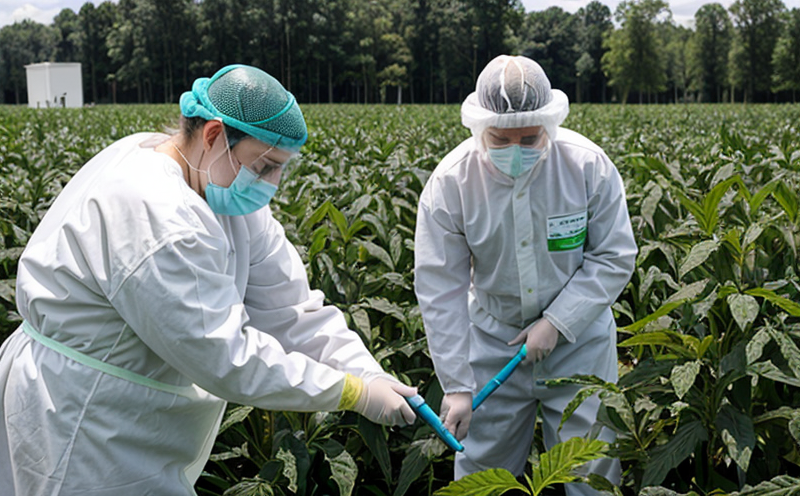AOAC 2014.05 Enumeration of Lactic Acid Bacteria as Beneficial Microbes
The AOAC International standard method AOAC 2014.05 is widely recognized for accurately enumerating lactic acid bacteria (LAB) within biocontrol agents and beneficial microorganism formulations. This test ensures the quantification of these crucial organisms, which play a pivotal role in promoting plant health, enhancing nutrient availability, and controlling pathogens.
Lactic Acid Bacteria are a diverse group of Gram-positive microbes known for their ability to produce lactic acid through fermentation processes. They are essential components of biocontrol agents designed to protect crops from harmful pathogens like Phytophthora, Fusarium, and other soil-borne pathogens. The enumeration process involves several key steps:
- Sample Preparation: Samples from biocontrol products or beneficial microorganism formulations are prepared by diluting them in appropriate media that support LAB growth.
- Culturing: Diluted samples undergo incubation at specific temperatures (typically 30°C) to optimize the growth of lactic acid bacteria. This step is critical for ensuring accurate enumeration.
- Counting Colonies: After a suitable incubation period, colonies are counted using standard colony-forming unit (CFU) techniques.
The method adheres strictly to international standards such as AOAC 2014.05, which ensures consistency and reliability across different laboratories. This approach guarantees that the enumerated counts reflect the true presence of LAB within biocontrol products, thereby ensuring their efficacy in field applications.
The importance of this test cannot be overstated, especially for quality managers, compliance officers, R&D engineers, and procurement teams responsible for sourcing reliable biocontrol agents. By adhering to stringent protocols like AOAC 2014.05, these stakeholders can ensure that the products they use meet regulatory standards and deliver consistent performance in agricultural settings.
The enumeration process is not just a technical exercise; it is a cornerstone of ensuring product reliability and efficacy. Accurate counting allows for better formulation adjustments, improved biocontrol agent design, and ultimately, more effective crop protection strategies. This method also supports compliance with international regulatory requirements, which vary depending on the target market.
Why It Matters
The enumeration of lactic acid bacteria through AOAC 2014.05 is crucial for several reasons:
- Precision in Formulation: Accurate counting ensures that biocontrol products contain the correct amount of beneficial microbes, which is essential for consistent performance.
- Regulatory Compliance: Adherence to international standards like AOAC 2014.05 helps ensure compliance with local and international regulations governing agricultural inputs.
- Product Reliability: Reliable enumeration methods enhance the trustworthiness of biocontrol agents, ensuring they meet the expectations set by end-users.
The precision provided by this method translates to better crop health and yield. By using AOAC 2014.05, stakeholders can ensure that their products are not only effective but also safe for use in diverse agricultural environments.
Moreover, the standardization ensures consistency across different batches of biocontrol agents, which is critical for maintaining product quality and efficacy over time. This reliability is particularly important in regions where regulatory frameworks may vary or where international trade is involved.
Benefits
The AOAC 2014.05 method offers several significant benefits:
- Enhanced Product Quality: Accurate enumeration ensures that biocontrol products contain the correct proportion of beneficial microbes, leading to superior performance.
- Improved Crop Health: By ensuring the presence and activity of lactic acid bacteria, these products contribute to healthier plants and better overall agricultural productivity.
- Regulatory Assurance: Compliance with international standards like AOAC 2014.05 provides assurance that products meet regulatory requirements, facilitating smoother market entry in various jurisdictions.
- Cost Efficiency: By ensuring product reliability through accurate enumeration, stakeholders can avoid costly recalls and re-formulations, leading to more efficient resource use.
The method also supports the development of new biocontrol agents by providing a standardized approach for quantification. This ensures that any innovations in formulation or application are rigorously tested against established standards.
Ultimately, the benefits extend beyond just the product itself; they contribute to sustainable agricultural practices and environmental health. By using AOAC 2014.05, stakeholders not only meet regulatory requirements but also enhance their reputation for delivering high-quality, reliable products.
Customer Impact and Satisfaction
The implementation of the AOAC 2014.05 method has a direct impact on customer satisfaction and loyalty:
- Confidence in Product Efficacy: Customers can trust that the products they purchase are accurately enumerated for lactic acid bacteria, ensuring consistent performance.
- Enhanced Reputation: By adhering to international standards, stakeholders enhance their reputation as reliable suppliers of high-quality biocontrol agents.
- Increased Repeat Business: Satisfied customers are more likely to purchase again and recommend the products to others, driving long-term loyalty.
- Better Decision-Making: Accurate enumeration data allows stakeholders to make informed decisions about product formulations and applications.
The AOAC 2014.05 method fosters a culture of quality and reliability, which is essential for building strong customer relationships. By providing precise data on the presence and concentration of lactic acid bacteria, stakeholders can meet the diverse needs of their customers across various agricultural sectors.





